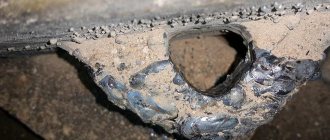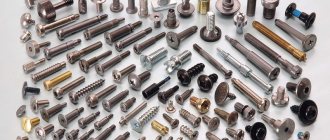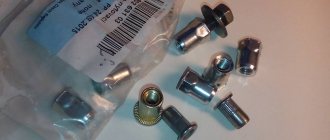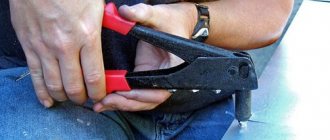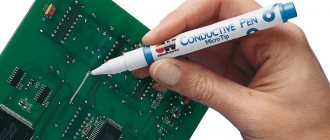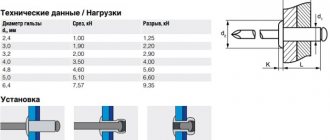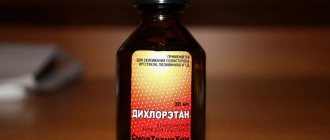From simple to complex.
The lock washer is familiar to everyone. It is used everywhere and is perhaps the most well-known remedy against spontaneous unscrewing of threaded connections.
The Grover is good because it combines the properties of a spring washer and a toothed one, and it is also cheap to produce.
But let's look at other options. After all, in addition to the locking washer, there are many other means to prevent bolts or nuts from loosening. We won’t talk about chemicals like Locktite - for now we are only interested in the simplest mechanical solutions in the form of washers and nuts.
So, there is also a spring washer that creates preload (just like the Grover itself) and prevents the nut from loosening:
A toothed washer is based on a slightly different principle. The teeth work both as springs and as spikes, biting into the material of the nut and body and preventing the nut from turning:
These three washers discussed above are more or less familiar to everyone. I think I won’t surprise anyone with a nut with a plastic ring, which is also a quite effective means of preventing self-loosening:
Nut with plastic ring
NEW SOLUTIONS
Now let's look at relatively new solutions in fixing threaded connections. Let's start with an analogue of a traditional washer with teeth.
Type 1. Fine tooth washer
The new type of washer has a fine notch on both surfaces, which, when tightened, bites into the material of the nut and the part and prevents them from rotating relative to each other:
fine tooth washers
There are also nuts with a built-in platform with similar teeth. By the way, they are quite widespread, unlike washers.
Type 2. Dispersing washers
The next option is an advanced modification of the previous washer. The system consists of two washers, the outer surface of which has a regular fine notch for biting into the material. But on the contacting surfaces, these washers have a slightly different tooth - like a ratchet. The configuration of this tooth allows the washers to scroll in only one direction - the direction of unwinding of the thread. Moreover, when you try to unwind the washers, a wedging effect occurs - both washers diverge and the outer teeth of the washers bite into the material even more strongly.
The washers must come in pairs. Between them they have a large tooth, which allows them to rotate relative to each other only in the direction of unscrewing the nut. On both outer surfaces there is a fine notch for biting into the material. The tooth angle is greater than the thread angle. This ensures a guaranteed wedging effect of the washers when trying to unscrew the connection.
Type 3. Nut with built-in riving washers
The next anti-twist solution is a nut equipped with the wedge washers discussed above:
Wheel nuts
The principle is the same, only the washers are rolled onto the nut, which is convenient, for example, when fastening car wheels. The nut is called “Wheel Nut”.
Type 4. Spring washers with wedging effect
The next modification of the same two washers with a ratchet tooth is spring washers. This, in addition to the advantages discussed above, also provides additional preload, which provides an even greater guarantee of reliable fixation of the threaded connection:
spring washers with wedging effect
Type 5. Self-deforming nut
The next modification is a specially shaped nut, which, when tightened, becomes slightly deformed, compressing the threads in its upper part and loosening slightly in the lower part.
Self-deforming nut
Deformation of this nut gives two positive effects at once. The first is in the form of relieving stress on the bolt in the area of the lower part of the nut and the second is fixing the thread in the upper part:
Tightened self-deforming nut in section
How to fix the pin in the block?
Rinse/blow out the hole, degrease both surfaces, apply a toothpick from the inside and onto the surface of the bolt, tighten the bolt. It will be ready in 15 minutes, and after a few hours you can load it to full capacity. Instead of a bolt, put a stud on the thread lock until it stops, a couple of turns should remain, and a nut on top.
Interesting materials:
What blooms on the trees in spring? What is the first thing to plant in spring? What to plant in a greenhouse in spring? What to plant in the spring at the dacha? What to plant in spring after garlic? What is sown in the fields in spring? What blooms in early spring? What blooms in early spring? What to add to the soil in spring? Why are trees whitened in the spring?
Lifehacks
SIMPLE WAYS
Perhaps the simplest solution, used since time immemorial, is to connect the heads of bolts or nuts with a wire tie
:
Also a well-known method, often found in automotive suspension and chassis components, is fixing the castle nut with a cotter pin
:
If the nut is ordinary, it can be turned into a castle nut by putting a stamped cover on it. Fixation occurs as in the previous case - with a cotter pin:
The next nut is the hub nut. If you look closely, you can see that the upper ring of this nut is flattened and looks like an oval. Due to this, the thread is clamped on several upper turns, which is what is required for fixation:
The flatness on the upper ring is visible, fixing the thread
Another solution using compression. This time the outer ring will be compressed, the annular toothed notch of which, when compressed, will fit into the reciprocal grooves of the toothed crown on the nut. This will secure the nut. Naturally, the outer ring is also fixed to the shaft using an internal spike, similar to the spike on a claw washer.
When the outer ring is deformed, the teeth close and fix the nut.
Fastening with claw washer
- a very common method in which a claw washer is held by an internal tenon in a groove in the shaft and one or more claws are attached to a nut with grooves located on the side surface:
COMPLEX METHODS
Type 1. SAPER LOCK nut
An interesting way of fixing a thread using some kind of spring that plays the role of a locking sleeve.
A spring is built into the nut, one of the ends of which protrudes in the form of a lever from a special groove on the side surface of the nut.
This protruding lever is needed when unscrewing. The fact is that when the nut is tightened, the spring, together with the nut, rotates freely along the thread without interfering with the tightening.
SAPER-LOCK nut device
And when trying to unscrew, i.e. By rotating the nut in the opposite direction, the spring compresses the threads and blocks the screw. You can unscrew the nut only by moving the spring lever to the extreme left position. To do this you will need to have a special set of heads.
The spring prevents the nut from unscrewing unless the lever is moved in the direction of unscrewing.
Type 2. SEAL LOCK nut
There is a plastic ring built into the lower inner part of the nut:
When tightened, this ring is deformed and takes the shape of the cavity formed by the body and the nut, thereby tightly pressing the thread and securely fixing it.
Type 3. SUPERBOLT nut
This type is used for large nut sizes. For example, there is a thread with a diameter of half a meter. How to tighten a nut onto such a thread with sufficient force? It is unrealistic to scale a regular hex nut to this size, because... To tighten it, you will need a corresponding monstrous wrench.
Instead, nuts are also used, but not hexagonal, but round. They are screwed onto the thread almost by hand, and force tightening is done with bolts located in this nut. The bolts rest against the washer installed under the nut and create the necessary tightening force.
The figure below shows how bolts 1, being in the body of nut 2, rest against washer 3 and pull nut 2 together with the central bolt 5, creating the necessary tightening force. Thus, we managed to move away from bulky nuts with enormous tightening forces to low forces on a larger number of bolts with a slight complication of the design.
The best plastic sealants
LOCTITE VR 5921
A viscous pasty mass of red-brown color, emitting a characteristic alcoholic odor. When the solvent evaporates, a very strong and elastic compound is formed. Suitable for fittings, assemblies and flanges. A top quality product that has earned positive reviews and approval from experts. It is completely safe, has good efficiency when interacting with different surfaces, has a long shelf life, and does not lose its initial properties.
LOCTITE VR 5921
Advantages:
- strong and elastic connection;
- top quality product.
Flaws:
- not detected.
Why are sealants needed?
Modern, universal and technologically advanced materials are special anaerobic compounds that polymerize in cracks and gaps in the absence of air. They are designed to secure and seal pipe threads.
To seal drainage and water supply systems, paste is often used. They are divided into 3 types:
- Non-hardening - the appearance is similar to a thick paste; the composition contains resins and polymers. It is the density that gives strength and sealing after application to the thread and screwing of the adjacent element. The parts are resistant to high temperatures and strong vibration from the water flow that occurs when opening the tap. But they cannot be used if there is high pressure in the system. Pressure will force the uncured paste out of the joint.
- Solidifying - the base consists of a solvent. Excellent properties guarantee correct fastening of the structure and reliable sealing of water pipes. Before starting the system, you need to wait 2 - 3 hours for the paste to dry completely. The drying process must be increased if work is carried out at low temperatures. Pastes that tend to harden are ideal for sealing high-pressure plumbing systems. The only significant drawback is that after drying, shrinkage occurs. Once the paste has completely hardened, it is very difficult to dismantle the connection. If it turns out that the thread is separated, the old layer is ground off, and then a fresh layer is applied.
- Anaerobic is the newest subtype of sealant containing acrylic polymer, which is in excellent demand among plumbers. In contact with metal, the polymerization process with active substances starts. As a result, a polymer similar to a cross-linked structure is formed. Having numerous advantages and advantages, they are not subject to corrosion and destruction by chemical impurities and substances found in running water, and can withstand critical temperatures (from – 90 to +200).
Composition of thread locker
The instructions for each product specify the components used in production. Each type will include different components, so you should carefully study the composition before purchasing. The level of connection depends on the composition, and determines the resulting properties.
The level of connection depends on the composition, and determines the resulting properties.
Automotive
Car seals have long outgrown conventional repair products. Currently, such sealants are used for many jobs that are performed when assembling a car at the factory. Often, with the help of such a mass, the fit of car gaskets is strengthened, and sometimes it is even used instead of a gasket. Nowadays it is very difficult to imagine repairing any auto-moto equipment without the use of sealants.
The main thing is to make sure that it is of high quality before use. Otherwise, you may stumble upon a material that will not hold oil or other liquid. If this happens, the work will have to be done again. Therefore, it is important to use only high-quality masses that are produced by trusted companies.
The best winding sealants
Matrix threads
New generation thread sealant of polymer type, used as a sealant for all types of threaded connections on pipes consisting of metal and plastic, intended for systems supplying hot and cold water for various needs, as well as drinking and technical water necessary for heating and gas supply . The sealant is wear-resistant, heat-resistant and resistant to aggressive environments.
Matrix threads
Advantages:
- can withstand water pressure up to 16 bar and gas pressure up to 8 bar;
- quite hygienic, does not decompose, prevents corrosion;
- instant sealing of the thread with high-quality connecting properties in the shortest possible time.
Flaws:
- not detected.
Henkel Tangit Uni-Lock
Intended for sealing pipes in connecting places for cold and hot water supply, for drinking water, heating and gas. Pipe joints can be adjusted after 72 hours from the time of assembly. Used to complement elements, plastic and metal pipes.
The appearance of the product appears ready for sealing fibers that include filament yarns. The contents of the container can be directly wound onto threaded pipes. The winding process is carried out to the desired location in the direction of the turns and begins from the end of the pipe.
Henkel Tangit Uni-Lock
Advantages:
- connections assembled on such a thread can be easily adjusted;
- very easy and simple to use;
Flaws:
- not detected.
MasterProf MR-UIS. 13 0199
In order to seal threaded connections, plumbing thread made of flax 55 m, 40 g is widely used. Excellent for assembling and twisting heating and plumbing systems.
MasterProf MR-UIS. 13 0199
Advantages:
- excellent sealing;
- durable;
- high quality.
Flaws:
- not detected.
FUM tape Valtec
This tape contains a fluoroplastic sealing material, which is perfect for sealing connections on the threads of pipelines through which gas and liquids that are non-aggressive to Teflon are transported. The exception is oxygen substances. Vaseline oil creates a film coating. There is a possibility of use at temperatures from – 20 to + 200 degrees. This does not require the use of additional sealants.
FUM thread sealing tape is very simple and easy to use. Suitable for use instead of mastics and aerobic sealants for strengthening on the threads of pipes consisting of any materials.
FUM tape Valtec
Advantages:
- very simple and easy to use;
- Suitable for use instead of mastics and aerobic sealants.
Flaws:
- not detected.
The difference between red, blue and green sealant
To accurately differentiate the characteristic properties, as well as the scope of application of fixing materials, manufacturers have come up with colored compounds in blue, red and green.
Blue
The blue tint material allows its use for metal pipes. The stability is at a fairly high level, so the connection is very simple. It has recently begun to be used in domestic settings, although previously it was used only for industrial purposes: aeronautical and defense industries, aviation and space-related industries. However, the pipes must have a diameter of no more than 20 mm, and when dismantling, the presence of special equipment does not matter. tools.
Red
The material in a red shade is used to seal worn out obsolete threads and metal pipes made of black metal alloy. The bonding quality does not suffer at all, despite the reduced setting time. He is not afraid of temperature fluctuations and high blood pressure. It is possible to use it with pipes not exceeding 30 mm in diameter. To dismantle joints, a heated tool is required. During repair work, the remaining material does not need to be removed. It is allowed to apply a new layer on top of the old one.
Green
It has the lowest specificity of connection, as a result of which it is a temporary fastening of metal and plastic. When dismantling, no special effort is required; it is done by twisting. There are no excellent characteristics indicating resistance to vibration and high pressure. The maximum permissible size of connecting pipes is 3.81 cm, provided the thread is intact.
How to work with thread glue
When using a retainer, it is distributed over the area where the nut should be, a thin layer is made, optimally up to 5 millimeters thick. When the parts begin to tighten, the glue will spread over the entire surface, ensuring reliable fixation.
When working with blind cracks, the product is applied to the bottom and not to the threaded area. It is recommended to clean and dry the part in advance. Also, better adhesion is achieved by treating the metal surface with a special brush.
When using a retainer, it is distributed over the area where the nut should be, a thin layer is made, optimally up to 5 millimeters thick.
How to Choose the Best Thread Locker
To get a high-quality result, you need to choose the right composition for the task. In this case, the criteria that influence the result are determined. Experts advise paying attention to: fixed moment of resistance, state of aggregation, resistance to process fluids, polymerization time.
To get a high-quality result, you need to choose the right composition for the task.
Fixed moment of resistance
This parameter helps you understand what size bolt the product will be suitable for. If the composition is intended for small bolts, then it will not be possible to obtain reliable fixation of large ones. Conversely, when small bolts are attached to reinforced clamps, then unscrewing them may become impossible. But manufacturers do not always specify this parameter.
This parameter helps you understand what size bolt the product will be suitable for.
State of aggregation
There are paste and liquid thread lockers. The first option is not so convenient to use, but they will not spread to unnecessary areas. Liquid types are standard for hard-to-reach bolts, but may bleed.
When choosing, take into account the size of the thread; the larger it is, the harder the option should be chosen for gluing.
When choosing, take into account the size of the thread; the larger it is, the harder the option should be chosen for gluing.
Resistant to process fluids
When operation involves exposure to different liquids, then when choosing a composition, you need to pay attention to indicating whether the layer can withstand this influence. If there are no such requirements, then you can choose any composition.
When operation involves exposure to different liquids, then when choosing a composition, you need to pay attention to indicating whether the layer can withstand this influence.
Polymerization time
The drying time for adhesives varies; they begin to perform their function only after the drying stage is completed. Manufacturers write how long it takes for complete polymerization. For urgent repairs, this parameter will be important.
The drying time for adhesives varies; they begin to perform their function only after the drying stage is completed.
Value for money
One of the most important parameters is obtaining good quality at an affordable price. Here it is better to focus on popular brands that have proven themselves as high-quality adhesives. They will be discussed in detail below.
One of the most important parameters is obtaining good quality at an affordable price.
Advantages and disadvantages
Thread sealant for bolts stands out for its ease of use, which is why they are often chosen. The popularity of the products is also due to the positive properties described below:
- After applying the product and drying, they do not move or shrink;
- Additional protection of the metal from rusty formations is created;
- The presence of different types of compositions facilitates their use for parts of different sizes;
- Adhesives for bolted joints prevent loss of fixation force, withstand vibration loads, as well as impact;
- Their consistency allows the composition to penetrate into the smallest crevices, providing an airtight seal.
Stop thread sealant also has disadvantages:
- Reinforced types of means do not make it possible to easily unscrew the threaded rods if necessary, then they resort to high-temperature exposure or special tools;
- When choosing, take into account the specifics of the material so that the composition does not damage its integrity;
- Adhesives dry quickly, so it is necessary to accurately apply the layer; it will be impossible to change the position of the bolts, and it is impossible to return the composition to a liquid state;
- You should not use adhesives at low temperatures, this affects how long the layer will take to dry, the period will become longer.
Thread sealant for bolts stands out for its ease of use, which is why they are often chosen.
Why use thread lockers?
Thread adhesive is able to complete polymerization when there is no access to air, resulting in an ideal connection of pipe parts, for example, in a water supply system. This avoids water leakage, gas escaping, etc. It also prevents parts from unscrewing under the influence of vibration and mechanical influences.
Using thread adhesive is simple, and there are different forms of similar compounds available. This allows every master to find a convenient option for his work.
Thread adhesive is able to complete polymerization when there is no access to air, resulting in an ideal connection of pipe parts, for example, in a water supply system.

